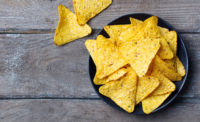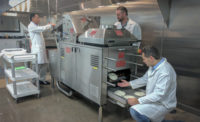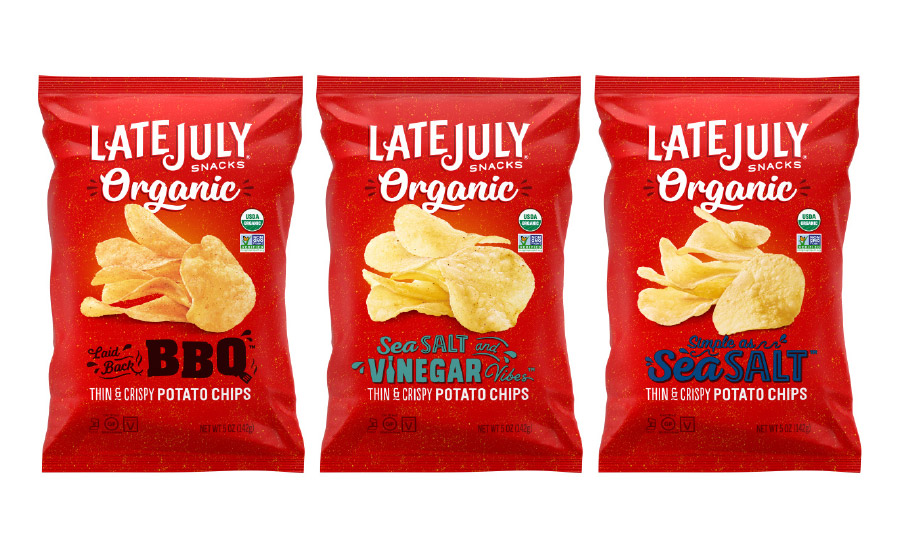State of the Industry 2020: Chips offer better-for-you options
Consumers search for healthier, spicier chip options.












Potato chips are a staple in most Americans’ pantries. While classic chips still command the bulk of U.S. market share, salty snack companies have begun to offer more better-for-you options, in addition to new and exciting flavor combinations.
Overview | Chips | Puffed/Extruded Snacks | Popcorn | Snack Mixes & Nuts | Tortilla Chips | Pretzels | Frozen Snacks | Crackers
Market data
According to data from IRI, Chicago, for the 52 weeks ending May 17, 2020, the potato chips segment—the largest in the salty snacks category—was up 4.6 percent, with total sales of $8.0 billion.
Frito-Lay leads the category with nearly 60 percent market share. Its sales for the year hit $4.8 billion, up 3.7 percent. The company’s top two brands both saw growth for the year, with Lay’s up 7.2 percent to $2.4 billion, and Ruffles up 2.7 percent to $1.1 billion. Ruffles Double Crunch chips, launched in early 2019, saw sales of $61.1 million for the year.
Kellogg Co. sits in the second spot for the segment, with $933.6 million in sales and an increase of 4.4 percent. Its core Pringles brand grew 4.1 percent to $825.0 million, while the Pringles Grab & Go Stack brand grew 4.0 percent to $59.4 million and Pringles Snack Stacks grew 11.9 percent to $49.2 million.
Campbell Snacks saw growth for two of its top potato chip brands: Cape Cod grew 7.9 percent to $282.4 million, and Kettle Brand grew 10.6 percent to $234.9 million.
Utz saw its flagship potato chips grow 10.8 percent for the year, up to $253.4 million. And its Zapp’s brand grew 30.4 percent to $50.5 million.
The apple chips segment drew in $28.1 million in sales, with a healthy increase of 26.4 percent. Bare Foods accounted for $17.8 million of those sales, with an increase of 29.4 percent. Seneca Foods brought in $8.7 million, with an increase of 26.9 percent. Private label showed a large increase in sales of apple chips, up 103.5 percent to $504,229.
Looking back
More than 6 in 10 consumers are wishing for healthier chip options, says Betsy Morreale, vice president, salty snacks, Campbell Snacks Division, Camden, NJ. Campbell’s took note of this evolving trend and launched Late July certified organic potato chips in January 2020. “Late July is the sweet spot of summer—when life is simple, pure and good. It was this moment in time that inspired us to create our Organic Potato Chips. We used thoughtfully chosen, organic ingredients to create one simple, but undeniably craveable chip,” she says. The varieties include “Simple as Sea Salt,” “Laid Back BBQ,” and “Sea Salt & Vinegar Vibes.”
Limited-time offerings (LTOs) are a strategic way to continually evolve offerings and provide something fun for consumers, says Matt Hoefer, brand marketing, Pringles, a Kellogg Co. brand, Battle Creek, MI. “Chicken and Waffles is one of our most-recent launches and is receiving some great reviews. Launched late last year, we have seen a lot of fans loving Roasted Parmesan and Garlic, too,” he says.
Pringles continues to see interest in unique flavors of every variety, driving an ongoing push for new offerings. “The impact and consumer interest in spicy cannot be overlooked, either,” says Hoefer. “The spicy chicken sandwich wars rocked the QSR world, and how hot a salty snack can be has been an evolving challenge. Consumers don’t just want hot, either—they want hot and flavorful. This is the new frontier in the spicy world.”
Amplify Snack Brands has long had a finger on the pulse of spicy salty snacks and recently released Krakatoa Hot Chips, named after Mount Krakatoa, an active volcano famous for its explosive nature. Each flavor’s level of spiciness is measured in quantifiable Scoville Heat Units (SHU)—the same scale used to rank spiciness of chile peppers—ranging from 5,840 to 38,700 heat units per chip. Flavors include Sour King (zesty lime with serrano pepper), Hot Hot Honey Pot (spicy honey with scorpion pepper), Mustard’s Revenge (hot Dijon mustard with cayenne pepper), Kung Pow! (Thai peppers with Szechuan pepper), and Black Magic (Creole heat with ghost pepper).
Tyler Groeneveld, commercial grains and oils leader, North America, Corteva Agriscience, Wilmington, DE, says that now more than ever, consumers are more aware of what they are eating and are looking for permission to indulge in snack food—especially as many individuals and families have been at home. “More grocery stores are adjusting the way they operate in order to minimize consumer interaction with food. Grocery and convenience stores have seen a large increase in the purchase of both individual and family sized prepacked snack foods, like chips,” he says.
In March, as the COVID-19 pandemic took hold of the nation, Groeneveld notes that U.S. consumers purchased roughly 50 percent more salty snacks than they did during the same time period in 2019. Stores saw sales of potato chips, pretzels, and popcorn rising by 30 percent, 47 percent and 48 percent, respectively.
“As consumers continue to snack more than eating three distinct meals, the desire for healthier snacks has increased,” Groeneveld says. “The better-for-you chip category is continuing to expand as consumers want high-quality food made with high-quality ingredients. This opens the door to using healthier oils. While snacking continues to appear closely tied to indulgence, the desire for more responsible and practical snack choices can be seen, including the 66 percent of snackers who wish there were healthier snack options.”
Teri Johnson, divisional sales manager, North America, tna solutions, Dallas, says that the snack food arena is incredibly fast-paced and dynamic, with a number of consumer trends driving growth. “Over the past year, we’ve identified three distinct trends shaping the category: healthy snacking, demand for greater equipment flexibility, and sustainability,” she says.
Health consciousness has expanded to include plant-based foods, which hit on both healthy eating and sustainability, additives for digestive health, and inclusion of CBD and hemp, Johnson continues. “This shift in dietary preferences underscoring wellness amongst consumers continues to drive innovation across the category. Keen to stand out in a competitive marketplace, brand owners are seeking innovative ingredients and cooking techniques to meet growing demand.”
For example, chip-style producers are using pre-treatments such as pulsed electric field (PEF) to reduce the uptake of oil in the frying process, and using healthier cooking oils, such as coconut oil or olive oil, to gaining traction amongst more-discerning consumers, says Johnson. “At the same time, health organizations have also been putting the spotlight on snacking in a bid to reduce the impact of unhealthy choices when it comes to convenience foods. Many of the initiatives put forward focus on regulated portion control. Smaller packaging sizes and single-serve portions are therefore on the rise, appealing to those looking to limit calorie intake and restrict portion sizes.”
Very closely linked with the trend for healthier snacks is the requirement for greater equipment flexibility, Johnson says. “The current global pandemic bears testimony to this, as essential for business. Before the COVID-19 crisis, the snack industry was geared toward smaller pack sizes. However, with quarantine snacking on the rise and the lines between meals and snacking blurring, manufacturers have had to re-align their production to accommodate large bag sizes. This has also left some packaging stations vacant, giving manufacturing a rare window of opportunity to carry out additional preventative maintenance and upgrades that will keep the line efficiencies high.”
It’s now imperative that packaging and processing systems offer the flexibility to switch quickly and easily from one production run to another, recommends Johnson. “A prominent example of this is with packaging equipment—producers need to be able to switch between different packaging film sizes and formats efficiently, with minimum downtime, while maintaining quality, verification, and traceability.”
Sustainability has also been high on the agenda, with brands looking to further improve the green credentials of their products, notes Johnson. “As such, snack food manufacturers have been looking for new and innovative ways to reduce their carbon footprint through switching to sustainable packaging materials and/or implementing more eco-friendly manufacturing practices. Packaging systems that allow manufacturers to successfully reduce film consumption of snack food bags, while also increasing throughput and improving operational performance, are highly sought after.”
Looking forward
Hoefer says that spicy will continue to be a prominent territory, but other bold and unique flavors will still find favor. “Bringing favorite flavors or foods to life in new and fun ways will be important drivers. We have some exciting new flavor varieties in the works for this year that will bring flavor to life for salty snack fans in a way that only Pringles can.”
Sustainability is a trend that is not showing any signs of slowing down, as it continues to be a major concern for both manufacturers and consumers, says Johnson. “In fact, with regulatory authorities imposing new rules in a bid to promote sustainable practices, it’s an opportunity for snack food producers to enhance their green credentials even further.”
Similarly, the rise of the socially conscious consumer will undoubtedly drive the use of more product claims in the snack foods category, Johnson notes. “The term ‘fair trade’ will find new meaning in the backdrop of heightened decibels on ‘equality,’ across the globe. Rising sentiments on diversity will propel discerning consumers to endorse brands and products that reflect their own aspirations to support a just and fair world. In addition to checking nutrition and dietary facts, ‘made in,’ ‘made from,’ and ‘locally sourced’ will find resonance and drive consumption patterns for a large group of individuals.”
Groeneveld says that over the past few months, consumers have shifted from eating out regularly to cooking and eating at home, leading to dramatic shifts in the industry that will carry into the future. “Grocery delivery and online ordering continue to increase as families look for limited-contact options for keeping their pantries stocked with food and snacks,” he notes. “Consumers will continue to demand free-from options, including foods labeled as additive-free, non-GMO, organic, and vegan.”
In terms of equipment, flexible equipment design is key to meeting ever-changing consumer demand, as it opens up the possibility for manufacturers to process multiple products on a single production line, says Johnson. “Market-leading vertical form/fill/seal (VFFS) technology, like the tna robag 3ci, has been designed with this concept in mind. No mechanical adjustments are needed when changing product or film, and digital data settings have been incorporated into the systems for rapid product or pack changes,” she explains.
Additionally, these systems offer a wide range of bag size and format options. Similarly, on-machine seasoning equipment that can handle a variety of different flavoring formats, such as wet and dry varieties, can offer manufacturers the ultimate versatility, Johnson says.
There are currently several options for supporting a more-sustainable way of packaging, continues Johnson. “The incorporation of innovative features such as single-serration jaws and automatic film splicing can not only help to reduce snack product packaging, but also improve operational performance to help meet growing consumer demands. In addition, by implementing power-saving software, the partial and phased shut-down and power-up components of equipment can be automated, optimizing the use of resources—from power to compressed air consumption. This helps plant managers improve economic efficiency, while lowering the environmental impact of their operations.”
Existing systems can also be retrospectively fitted with auxiliary equipment. Metal detectors, date code printers, and bar code readers, for instance, can enhance levels of transparency throughout the production line, says Johnson. “By spotting any inaccuracies or miscoded products early in the process, they can reduce the risk of any poor-quality items entering the market—helping manufacturers save valuable time and resources.”
Overview | Chips | Puffed/Extruded Snacks | Popcorn | Snack Mixes & Nuts | Tortilla Chips | Pretzels | Frozen Snacks | Crackers
Looking for a reprint of this article?
From high-res PDFs to custom plaques, order your copy today!












